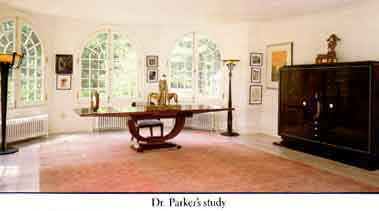It is difficult describing Erte to someone who has never met him because words always fail to convey his essence. Erte's special quality, which I have never seen in anyone else, is obvious the moment you meet him. He is a spiritual genius who quietly and beautifully makes his presence known. My son, Damien, enjoyed his
visits to our New York apartment because Erte always had a meaningful exchange with him and took time to play with his dog "Deco. " Damien's interest in art and sculpture today has been greatly shaped by knowing Erte and growing up with his works in our home.
My working sessions with Erte were greatly expanded when my company, R. K. I. International Corporation, became the first publisher of his sculpture collection in 1980. Most people are unaware of the fact that Erte started sculpting in 1958 what he calls formes picturales - abstract bursts of aluminum covered with vibrant oil paint. He is far better known for his bronze sculptures of fashion, fantasy, theatre and opera. One of the greatest thrills of my life was when Erte said, "Were it not for Ronald Parker, my sculpture would have remained a private pursuit. " If I have been a catalyst for this genius, I thank God for this supporting role I have played.
Neither Erte nor I anticipated that the sculpture collection would
be as successful as it has been. These pieces touched viewers both emotionally and aesthetically.

The original distribution company for the Erte Sculpture Collection was Fine Art Acquisitions, Ltd. (FAA). Harris Shapiro and I started this company in 1980. As President of FAA, I opened the first Dyansen Gallery (named after my wife) In 1981 in Soho. Soon after, the R. K. Parker Gallery (low called Dyansen Eclipse Gallery) opened. In 1983, after FAA became a public company I sold my interest in Erte sculpture, FAA and my gallery to FAA. Shapiro and his colleagues have since opened their own venture. The company; which is now called Dyansen Corporation, into) the largest public art company in America. I invested my money enthusiastically in a new publishing venture focusing on Erte's objects of art. It is not well known that Erte has designed every conceivable item for the home. Remember that his theatre and opera stage settings are designs for interiors. His designs fir the films Rest less Sex, Paris and A Little Bit o f Broadway were masterpieces of interior design. His bowls, vases, mirrors, lighting, fire screens and other home accessories were also a part of his illustrations for the Harper's Bazaar fashion features as well as feature articles in the French publication Art et Industrie. Not one Erte collector in a hundred leas ever seen Erte's masterpieces in Art et Industrie. Were this body of work widely known, everyone would hail him as the most important artist-designer of the 20th century.
Charles Spencer, his biographer, writing in Art and Design, November 1986, expressed Erté's breadth well: "It is clearly too narrow to limit Erté's genius to fashion and theatre, the two areas for which lie has become world famous I hope I have demonstrated that throughout his long professional career lie has displayed a continuing interest in art, architecture and design, formulating his own interpretations of contemporary developments, expressing them both ill his own homes and ill his work for magazines, cinema and the stage, as well as for clients who have employed these talents."
It is a challenge to think of an artist-designer more important in the 20th century than Erté. I can't. Picasso as an artist, perhaps. Wright as a designer, possibly. Baksts ballet designs were masterful but his range was limited compared to Erté's. Who but Erté excels over all others as the consummate artist -- With over 22,000 original art/design creations to his name, the depth and breadth of his artistic gifts are astounding. --I have reviewed his published and unpublished works hundreds of times during the last 20 years. And I find myself more fascinated and more impressed with him today than ever before. For those few who complain that they have seen too much Erté, I suggest that they have not looked carefully at what they have seen and they haven't seen enough. Each of Erté's pieces display an imagination and gift that has rarely been seen in man's history. You have to look at the creations of Mozart's Music to find an artistic equivalent to Erté. And like Mozart, Erté's artistic genius manifested itself when he was four years old! Erté began designing at four and sculpting at six!
My own bias toward Erté is well known, but what about the "experts"' views? Both critics and museum Curators greatly admire Erté's creations. John Russell, writing in the London Times, said that "were Michelangelo to return to life today; lie Could not be afforded a better reception than Erté is today, receiving." The major museums of the world have added Erté to their permanent collections, including the Victoria and Albert Museum in London and the Louvre in Paris. A very important fact is the following: the Metropolitan Museum of Art in New York owns more original works of art by Erté than any other living artist. Museums and critics provide us with objective longstanding validation of his greatness and his Important place in art history.
I have my own explanation for Erté's artistic gifts - and that is that, he is divinely inspired and God has worked through this genius for many lifetimes. Erté is able to envision each of his pieces totally completed before lie starts to work. He has no need for studies or sketches; lie has a perfect "eve" for design balance, proportion and line. His artistic miracles have no equal except in nature, from which Erté has received enormous artistic inspiration. The following quote describes Erté well: "the works [are]... notable for boldness of design, the subtlest imitation of Mature in trifling details, good rule, better order, correct proportion, perfect design and divine grace, prolific and diving to the depths of art, endowing his figures with motion and breadth. " (Written in 15 50 by Vasari describing the work of Leonardo da Vinci!)
Why collect objects of art?
With the publication of Erté's unprecedented collection of objects of art, I am able to offer both the experienced as well as the new collector a truly exciting opportunity.
Because this remarkable body of work, created by au
acclaimed master, is virtually unknown, it will be all the more treasured by those who recognize both its beauty and its immediate value in the art
market.

I have been collecting objects of art from the 1920s for a long time myself. While taking great pleasure in the elegant way they enrich my environment, I leave also seen their worth increase significantly.
I believe the fusion of artist and designer represents the most important area of investment potential for collectors over the next decade. What better way to seize this opportunity and enhance your own elegant living style than with the addition of an Erté object of art?
Any collection begins with a single object.
About 15 years ago, I decided to make an investment in living the only furniture, objects and Home accessories I would buy would be designed by artists. In furniture I chose Pullman's desk, cabinet, dining room table arid chairs plus ail elegant coffee table composed of rare woods arid ivory inlay. One of his desks was the first piece of 20th century furniture to reach $100,000 at auction. 1n 1988, two of Ruhlmann's pieces (a desk and a cabinet) from Mr. Chow's collection realized
$1,000,000 each. I bought my first Ruhlmann for $5,500 from Lillian Nassau with $500 down and the balance to be paid over one year. Lalique crystal, Brandt ironwork arid Dunand vases were also a part of my investment in living. What full not only to live with beautiful things but to see them go up in value!

As much as I enjoyed collecting Rullmann, Lalique, Brandt, Dun and others, I knew that the most important artist
It is important to note that in the 1980s museums and collections were beginning to place enormous emphasis on objects of art. In the October 24, 1985 New York Times, Rita Reif declared, "The passion for collecting decorative arts is changing the look of the nation's living rooms and bringing broad revisions and expansions in America's museums. . . the new interest in decorative arts is clearly seen in four major museums, all of which have built or are building new wings for their collections. " (These arc the Metropolitan Museum of Art, the Art Institute of Chicago, the Virginia Museum of Fine Art arid the St. Louis Museum.) However, in 1986, the Whitney Museum, known primarily for its painting and sculpture exhibitions, mounted an impressive exhibition of American Design which was its most complex foray into the decorative arts in its 55-year history. One can walk through any period room in a major museum and quickly notice that the living environments arc filled with the most wonderful furniture, objects of art and paintings. The affluent of all ages have surrounded themselves with beautiful things
Erté's Objects of Art enhance the beauty of one's home and the pleasure of one's life.
In October 1920 in Harper's Bazaar, Erté wrote that an artist should create each piece of furniture for a person of "cultivated tastes." He added, "Sooner or later a person of cultivated tastes will also realize that the objects forming one's home setting should be designed with the same intelligence and artistry."
Imagine any item for the interior of a chateau, home, restaurant, theatre, nightclub or resort - and Erté has designed it. He has brought his talents to landscape architecture, floral arrangement fabric, luggage, bird cages, boxes, trays, frames, fish tanks, and all forms of lighting - chandeliers, sconces, table mid floor lamps. Erté designs for hundreds of objects of art have beck published, yet few have been fabricated. The challenge for Erté, the Estoricks and me was to sort through the published and unpublished sources and select the most magnificent examples for production. This was not an easy task for two reasons: the sheer volume of the work is almost overwhelming; arid how can one select the "best" from a universe which is so consistently remarkable? Nevertheless, thousands of pages of material were reviewed and a publishing program was planned. 1n 1985 I released the first Erté object of art made available through this effort. It was a table mirror called "Transcendence." It was an instant success because galleries and collectors did not view it as a mirror. Additionally, the first 22 pieces were sold to people who were not Erté collectors. They simply "fell in love" with the piece and had to have it! The piece was correctly perceived as a mixed media (bronze, glass, plexi and brass) work of art. Its design, beauty and craftsmanship rivaled the most beautiful objects most people had ever seen! Everything was right about this piece, including its $1,800 price (today it commands $3,400).
The time for collecting is now.
Apart from the sheer joy and delight that comes from living with beautiful things, there are three reasons why today is the best time to collect objects of art. The 1980s are only the beginning of a surge of interest in this field which I believe will outdistance sculptures and rival paintings as the preferred art for collectors during the Next 25 years.
Art in your home makes an important statement about you.
First, collecting today is tied to the question of identity. Traditionally we have defined ourselves primarily ill terms of our vocation -- a doctor, an attorney, a contractor, etc. This definition of identity is no longer adequate. We want an identity which involves intelligence, creativity and challenge. Surprising as it may seem, being an art collector provides part of ail identity which can help us define ourselves and improve our self.
One does not have to be wealthy to be a collector. My first purchase (a woodblock print) cost $30, and my first sculpture was $45; I still have them' In 1984, I bought a Renoir sculpture. In 1986, I bought a Monet painting. While it is thrilling to own these Impressionist masters, I enjoyed just as much buying a far less expensive antique Lalique paperweight last month. Collecting call begin on any budget. It can provide a lifetime of pleasure for oneself and the family and it is frequently financially rewarding. The challenge is to use intelligence and creativity to assemble an environment of beauty and value.
An Erté collection exhibits your taste for today's elegant lifestyle in objects of enduring beauty and value.
The second reason why today is the best time to collect objects of art is lifestyle. Television provides us with a profile of what much of America is seeking today in their lifestyles. Opulence and conspicuous consumption are presented today ill a more extreme form than anything we have seen in our history. Shows like "Dynasty" and "Dallas" present fabulous worlds of wealth, power, romance and obsession with glamour seems almost a throwback to the glittery fantasy worlds that Hollywood created in the 1930s and 1940s. Television, however, provides us only with a set decoration idea of elegance and style. One must look to real life to see tile true personification of style and elegance -- to those few individuals who have a natural talent for the timeless elegance that style represents. While Noel Coward, Fred Astaire and Cary Grant are among them, only Erté truly personified style, that individual, original and unique characteristic that is so difficult to define, but which everyone can recognize. The opportunity to own even a small piece of his work enables us to possess a portion of that style forever. The way you live, the art you acquire, speaks eloquently about who you are. Objects of art are easy to collect because they are so accessible. Erté believes that beautiful things should be in daily use. Surrounding yourself with works of art brings constant enjoyment. Your friends are always the first ones to appreciate the beauty of your objects of art collection.
The artist-designer is currently commanding unprecedented attention in the art world.
The third reason I believe that now is the time to collect objects of art is that more artists are creating them - a distinct trend is emerging and auction records are being set for all categories of objects and decorative arts. The beauty is obvious in the ceramic bowls of Picasso, the screens of Klee, Pendergast, Dunand, Chagall, Gray, Dine and Youngerman, the mirrors of Tiffany, Brandt and Erté, and the vases of Lalique and Erté. Galleries and museums are mounting exhibitions of objects of art as never before. The recent exhibition of lighting in the Center Pompidou illuminates the worldwide interest of major museums in functional art. Narrowly
The auction market could not be "hotter" for objects of art than it is right now. Tiffany and Wright table lamps have now each sold for over $400, 000. A Dunand lacquered table sold for over $300,000 and one of his vases recently reached $121,000. The new source of auction activity is the artist-designer. A Cheuret chandelier recently sold for over $100,000. People with almost unlimited money - like Warhol, Elton John and Johnny Carson - have all chosen Erté.

- End -
Back to the Objects Main
Page
Objects in Detail
!